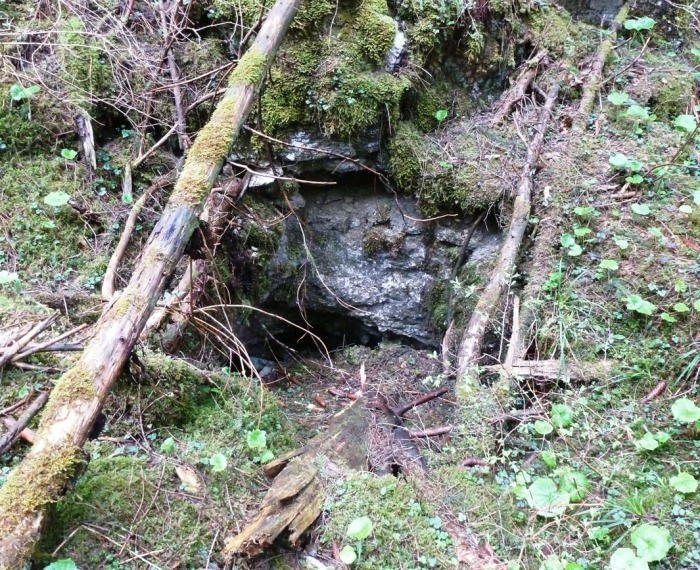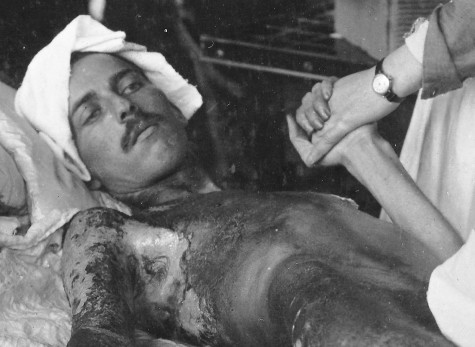The death in action of her brother Edward, in Italy in June 1918, forms the final tragedy of Vera Brittain‘s memoir Testament of Youth.
Edward Brittain applied for a temporary commission in September 1914, when he was not yet nineteen years of age.

His parents gave their consent to Edward’s application, signing this statement written by him. (National Archives WO339/27827)
He was posted to the 11th Sherwood Foresters in February 1916 and badly wounded during the Battle of the Somme on 1st July when was also awarded the Military Cross for bravery.

Edward Brittain after the award of the Military Cross (Literary Executors for the Vera Brittain Estate, 1970 and The Vera Brittain Fonds, McMaster University Library)
He was eventually found fit for further overseas duty in March 1917 and returned to his battalion in France. In November his battalion was sent to Italy.
On 15th June 1918, the Austro-Hungarian army launched a major offensive in Italy, part of which fell against British forces on the Asiago plateau. The 11th Sherwood Foresters held San Sisto Ridge, a small, steep, wooded hill, rising 60 metres above the plain. Two companies of the Sherwood Foresters held the front line forward of the ridge, which ran just within the tree line. Captain Brittain commanded ‘A’ Company which held the right hand section of the front line.

Part of the British front line held by Edward Brittain’s company in June 1918, known as Alhambra Trench, in 2015 military barbed wire now keeps cattle out of the woods.
In front were picquets of about ten men from each company with four machine guns. At 3am the Austrians began a bombardment of the British positions which lasted for four hours and included gas shells on the front lines. The volume of gas was so great that it rolled down the rear slope of San Sisto Ridge into the valley behind. At 6.45am the picquets saw troops led by small groups of stormtroops with flame throwers emerging through gaps in the Austrian wire.

The direction from which the Austrian attack came. The rocky outcrop to the right was the location of two British machine guns; the ten-man picquet from Brittain’s A Company was just beyond. The town of Asiago is in the valley behind.
At the time of the attack, Brittain was liaising with French troops immediately to the right. His Company had about 50 men after the bombardment, to hold about 800m of front line and he was probably the only unwounded officer in the company. One of the machine guns in front of Brittain’s company was destroyed but the picquet opened fire as did the remaining machine gun which fired 1,000 rounds and inflicted heavy losses on the attackers. However the attackers managed to outflank the picquet and machine gun forcing them to withdraw, which in turn caused the left hand machine guns to pull back. The Austrian attackers began to crawl towards the British wire and found a route through at the junction of the two companies of the Sherwoods. Entering the British trenches, the Stormtroopers were followed by trench clearing parties which worked left and right with grenades and flamethrowers, capturing 200m of the front line.

The deployment of British at the start of the battle. The 11th Sherwoods were holding the front line with D Company on the left and Brittain’s A Company on the right; C Company was on the ridge summit behind. Machine guns R1 and R2 were deployed in front of the British wire, as was a picquet of ten men. The Austrian break-in is shown by the red arrow and the area in which Edward Brittain lost his life is shown by the cross. (23rd Division GS War Diary National Archives WO95/4229)
Soon between 100 and 200 attackers were in the British trench, as the Sherwoods attempted to block the trench at either end of the break-in. Brittain immediately led a counterattack, forcing some of the Austrians back through the wire, and reorganised the defence. It was as he looked out for signs of the Austrians that he was killed, reportedly shot through the head by a sniper.

The area of Alhambra Trench retaken by Brittain’s counterattack where he was killed shortly afterwards.
Brittain’s Company was now officerless and the Austrians had at least ten machine guns inside the British wire. They resumed pouring through the gap into the British front line and about thirty pushed up a communication trench to the summit of the ridge into an undefended length of trench.
A counterattack organised by the commanding officer of the 11th Sherwood Foresters, a 26-year-old Lieutenant Colonel, Charles Hudson, forced the Austrians back and retook the ridge but soon afterwards Hudson was seriously wounded by a grenade. A second British counterattack consolidated the hold on the front line.

The top of a British petrol tin, used for transporting water to the front line, San Sisto Ridge, 2015.
The War Office telegram sent to Edward’s father on 22nd June 1918. (National Archives WO339/27827)
Vera Brittain visited Hudson in 1918 and in Testament of Youth describes how he told her that her brother was “sniped” by an Austrian officer and shot through the head, just after the counterattack which he had led. She also quotes from a letter received from a Private in her brother’s company: ‘Shortly after the trench was regained Capt. Brittain who was keeping a sharp look out for the enemy was shot through the Head by an enemy sniper, he only lived a few minutes.’

Edward’s grave at the end of the row buried with men from his Company. In September 1921 Vera visited the cemetery and planted rosebuds and a small asparagus fern beside her brother’s grave.
After the publication of Testament of Youth Hudson wrote to Vera stating that shortly before the attack a letter from her brother had been opened by the censor and found to contain references to homosexual activity with men under his command. Hudson said that he warned Brittain obliquely that his letters were read the day before and believed that as a result Brittain had deliberately sacrificed himself during the attack. Edward Brittain’s army service record contains no reference to this. Edward’s death is thought to have contributed to their father’s suicide in the Thames in 1935.
The account of the action on San Sisto Ridge is based on Francis MacKay, Asiago (2001) with reference to War Diaries of 11th Battalion Sherwood Foresters (WO95/4240) and General Staff 23rd Division (WO95/4229), and Percy Fryer, The Men from the Greenwood (1920). Reference to the revelations by Charles Hudson is made by Mark Bostridge, Vera Brittain and the First World War (2014).
Join me on a battlefield tour with The Cultural Experience:
The War Poets: Words, Music and Landscapes, 6th-9th July 2023
First & Last Shots 1914 & 1918
Medics & Padres in the Great War
Walking the Somme, Summer 2023
More Information about Battlefield Tours
Where did Vera Brittain serve in France during the First World War?
The most effective chemical attack ever staged: the gas attack at Caporetto, 24th October 1917
Col di Lana: the First World War in the Dolomite mountains
Home and more posts
Contact me
















A great piece of research -thank you for posting. Appreciate the photos as well. For some years now I had thought that there was some credence in the theory that Edward Brittain may have deliberately exposed himself to enemy fire following the threat of court martial . After reading this blog I am starting to doubt this .It’s hard for us who have never had to face enemy fire to imagine what goes through someone’s mind in that situation, and perhaps it’s best that we don’t try to speculate.
You should read the original account of the mystery surrounding Edward Brittain’s death in Paul Berry and Mark Bostridge, Vera Brittain: A Life (1995). This would augment some of the suggestions you make here.
Many thanks for the valuable suggestion Daniel. I’ve read it but wasn’t pursuing the question of Edward Brittain’s sexuality in my article. Miles Hudson’s biography of his father Soldier, Poet, Rebel sheds some light on the battle as experienced by Charles Hudson.
Hello Daniel, have read the ‘Vera Brittain: A Life’ (1995) , also Mark Bostridge’s further commentaries on the subject in his anthology ‘Lives for Sale’-Biographers’ Tales’ in his piece ‘Ipplepen 269’. Also ‘Soldier, Poet, Rebel ‘ as mentioned by Simon. Feel have given a lot of time to the case for the proposal that Edward Brittain deliberately exposed himself to enemy fire. But as I said, the more I read about the matter, the more doubts that I have that there is anything more than circumstantial evidence that Edward somehow wanted to his end his life . I think that Mark Bostridge was right to explore the possibilities as Vera’s biographer. And remembering Edward with honour today on the anniversary of his death.
Many thanks Michael. I was a bit obtuse in that I didn’t spot that Daniel was responding to your comment rather than mine.
Thank-you for this. I’m reading ‘Testament of Youth’ at the moment. Taking a very long time as I keep having to research on the battles, etc. This is very interesting, and more importantly, very clear.
There is absolutely no evidence that the disclosures about Edward Brittain’s sexuality contributed to Thomas Brittain’s decision to commit suicide in 1935. Mr Brittain was a serious depressive and had made other suicide attempts earlier in the thirties, see Berry and Bostridge, Vera Brittain: A Life (1995)
I have just watched the film “Testament of Youth” and cried my eyes out!! I must say I was ignorant of the book and only knew the name of Vera Brittain as an author…I have now come across this and am looking through all the rest of the info I can get online. I think the actress who played her part was exceptional.
(My father was a Para at the Battle of Arnhem, joined up at 17 yrs) and I tell my children all the time about the bravery of their grandfather, whom they never met, and the hopeless waste of life in both WWI and WWII and all the rest to follow.
I think my Great Grandfather, Joseph Hunt, is buried in the same row as Edward – Row B third from the left hand end. He was a private and died on 16.6.1918 leaving a wife and four young children, the youngest being my grandmother. I visited his grave in 2019 – the first family member ever to do so and made an entry in the cemetery register.
The Granezza British Cemetery is in a beautiful location.
Graeme Smith
Great Grandson of Private Joseph Hunt -Sherwood Foresters (Notts & Derby Regiment)
Thank you that’s fascinating. Yes it is a beautiful location.
Among other personal artefacts I also have the actual letter which was written by Joseph’s Qtr Master Sgt to his widow Lucy Hunt, my Great Grandmother, assuring her that his death was instantaneous and his resting place is in a quiet and beautiful location away from the front line. Written on air mail paper I really had to decipher the content but found it quite moving and comforting to know that as bad as conditions were somebody was able to make the time to convey such awful news with a lovely personal letter.
What a remarkable thing to still have and very precious.